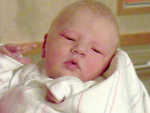Opinion
Random things about the Milky Way
Thursday, February 26, 2009

Evelyn Nadine Vinton
The good folks at the Internet social gathering place Facebook have started something. It is called "25 Random things About Me." This is where, if you have a Facebook account, you can enter 25 random facts about yourself.
While some folks may find that something "awesome" to do, I am not particularly moved by that. In fact, I don't even have a Facebook account.
The parents of my new granddaughter have, however, made a Facebook account for her. Imagine, the prettiest, most lovable, adorable, smartest, best granddaughter in the world, born on Feb. 14, at 8 pounds and 21 inches named Evelyn Nadine born to my daughter Stephanie and her husband Matthew Vinton have created a Facebook account for her where they posted all the photographs I took of her on her birthday.
Whew, sorry, I had to get that in, being a grandfather and all.
Anyway, taking that thought of 25 random things a little further, the people at oneminuteastronomy.com posted an entry called "25 Random Things About ... The Milky Way." You know, the galaxy we live in.
I am not going to list all 25 here, you can go to the One Minute Astronomer site for yourself and do that. I am however going to select a few of the most interesting tidbits to share with you.
1. Wherever you live in the world, and whatever the season, if you have a dark sky you can step outside on a clear night and see the nearby spiral arms of the Milky Way.
2. The Milky Way has a diameter of 100,000 light years and is about 1,000 light years thick. You remember the light year don't you? Light traveling at 186,000 miles per second for a year will travel about six trillion miles. You can do the math on this one.
3. There are about 300 billion stars in our galaxy. If we figure with that many stars in just our galaxy alone, and there are millions of galaxies, no wonder some people believe, "We are not alone."
4. Our sun lies about 26,000 light years from the center of the Milky Way. At that distance and moving at the speed of 220 kilometers a second, we rotate around that center once every 220 million years.
5. Speaking of the center, at the center of our galaxy is a ginormous black hole with a mass of four million suns that is violently gobbling stars and matter and sending out highly energetic X-rays. There is, however, no danger of our sun being one of them.
6. Galileo was the first to discover that the Milky Way is made of stars. He was the first person to turn a new invention, the telescope, upwards to the heavens. In fact, this year is the 400th anniversary of that event. That is why 2009 has been declared the International Year of Astronomy.
7. The Andromeda Galaxy, the nearest one to us, is approaching our Milky Way at 100 kilometers a second. At that speed the two giant galaxies will collied in roughly two billion years. Not to worry however. There is hardly any chance that any of the stars in either galaxy will collide, it will be more like a merge. Both galaxies will lose their spiral shape and coalesce into one big, fuzzy, round, blob called an elliptical galaxy. Seems a shame doesn't it? All the beauty of both spirals lost into a single, round blob.
8. Last, but by no means least, because of global light pollution, most children in the world will never be able to see the Milky Way.
SKY WATCH:
A beautiful slender crescent moon will have a close conjunction with the planet Venus on Friday. Look about 6:30 p.m. in the west.
NEXT TIME:
More astronomical blathering.

